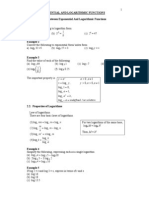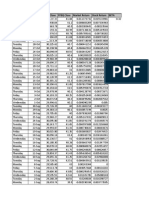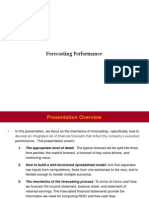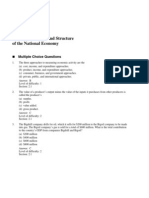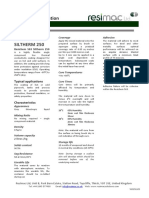Log Functions With Applications
Uploaded by
k_Dashy8465Log Functions With Applications
Uploaded by
k_Dashy846512.
Logarithmic Functions and Their Applications
(1213)
657
12.2
In this section
G G G
LOGARITHMIC FUNCTIONS AND THEIR APPLICATIONS
In Section 12.1 you learned that exponential functions are one-to-one functions. Because they are one-to-one functions, they have inverse functions. In this section we study the inverses of the exponential functions.
Denition Domain and Range Graphing Logarithmic Functions Logarithmic Equations Applications
Denition
We dene loga(x) as the exponent that is used on the base a to obtain x. Read loga(x) as the base a logarithm of x. The expression loga(x) is called a logarithm. Because 23 8, the exponent is 3 and log2(8) 3. Because 52 25, the exponent is 2 and 1 1 log5(25) 2. Because 25 32, the exponent is 5 and log232 5. So the logarithmic equation y loga(x) is equivalent to the exponential equation ay x.
loga(x)
G G
For any a 0 and a
1, if and only if ay x.
y loga(x)
E X A M P L E
Using the denition of logarithm Write each logarithmic equation as an exponential equation and each exponential equation as a logarithmic equation. b) 6 log14(x) a) log5(125) 3 m 1 c) 8 d) 7 3z 2
Domain of f f (x) = 2 x 5 f
1 (x)
Range of f
32 = log 2(x)
1
Solution a) The base-5 logarithm of 125 equals 3 means that 3 is the exponent on 5 that produces 125. So 53 125. 6 x by the denition of b) The equation 6 log14(x) is equivalent to 1 4 logarithm. m 8 is equivalent to log12(8) m. c) The equation 1 2
d) The equation 7 3z is equivalent to log3(7) z.
Range of f
Domain of f
FIGURE 12.8
The inverse of the base-a exponential function f (x) ax is the base-a logarithmic function f 1(x) loga(x). For example, f (x) 2x and f 1(x) log2(x) are inverse functions as shown in Fig. 12.8. Each function undoes the other. f (5) 25 32 and g(32) log2(32) 5.
To evaluate logarithmic functions remember that a logarithm is an exponent: loga(x) is the exponent that is used on the base a to obtain x.
E X A M P L E
Finding logarithms Evaluate each logarithm. a) log5(25) d) log10 (0.001)
1 b) log2 8 e) log9(3)
c) log12(4)
658
(1214)
Chapter 12
Exponential and Logarithmic Functions
helpful
hint
When we write C(x) 12 x, we may think of C as a variable and write C 12 x, or we may think of C as the name of a function, the cost function. In y loga (x) we are thinking of loga only as the name of the function that pairs an x-value with a y-value.
Solution a) The number log5(25) is the exponent that is used on the base 5 to obtain 25. Because 25 52, we have log5(25) 2. 1 1 is the power of 2 that gives us . Because 23, we b) The number log2 1 8 8 8 3. have log2 1 8 1 2 that produces 4. Because 4 , we c) The number log12(4) is the power of 1 2 2 have log12(4) 2. d) Because 0.001 103, we have log10(0.001) 3. . I e) Because 912 3, we have log9(3) 1 2
There are two bases for logarithms that are used more frequently than the others: They are 10 and e. The base-10 logarithm is called the common logarithm and is usually written as log(x). The base-e logarithm is called the natural logarithm and is usually written as ln(x). Most scientic calculators have function keys for log(x) and ln(x). The simplest way to obtain a common or natural logarithm is to use a scientic calculator. However, a table of common logarithms can be found in Appendix C of this text. In the next example we nd natural and common logarithms of certain numbers without a calculator or a table. Finding common and natural logarithms Evaluate each logarithm. a) log(1000) b) ln(e) 1 c) log 10
E X A M P L E
calculator close-up
A graphing calculator has keys for the common logarithm (LOG) and the natural logarithm (LN).
Solution a) Because 103 1000, we have log(1000) 3. b) Because e1 e, we have ln(e) 1. 1 1 , c) Because 101 10 we have log10 1.
Domain and Range
The domain of the exponential function y 2x is (, ), and its range is (0, ). Because the logarithmic function y log2(x) is the inverse of y 2x, the domain of y log2(x) is (0, ), and its range is (, ).
CAUTION
and a
Because the domain of y loga(x) is (0, ) for any a 0 1, expressions such as log2(4), log13(0), and ln(1) are undened.
Graphing Logarithmic Functions
In Chapter 11 we saw that the graphs of a function and its inverse function are symmetric about the line y x. Because the logarithm functions are inverses of exponential functions, their graphs are also symmetric about y x.
E X A M P L E
A logarithmic function with base greater than 1 Sketch the graph of g(x) log2(x) and compare it to the graph of y 2x.
12.2
Logarithmic Functions and Their Applications
(1215)
659
calculator close-up
The graphs of y ln(x) and y e x are symmetric with respect to the line y x. Logarithmic functions with bases other than e and 10 will be graphed on a calculator in Section 12.4.
3
Solution Make a table of ordered pairs for g(x) log2(x) using positive numbers for x :
x g(x) log2(x)
1 4 1 2
1 0
2 1
4 2
8 3
Draw a curve through these points as shown in Fig. 12.9. The graph of the inverse function y 2x is also shown in Fig. 12.9 for comparison. Note the symmetry of the two curves about the line y x.
y 5 4 3 2 y=x
y = 2x
3
5 4 3 2 1 1 2 3 4
g(x) = log 2(x)
f(x) = loga(x) (a > 1)
FIGURE 12.9
(1, 0)
All logarithmic functions with the base greater than 1 have graphs that are similar to the one in Fig. 12.9. In general, the graph of f (x) loga (x) for a 1 has the following characteristics (see Fig. 12.10): 1. 2. 3. 4. The x-intercept of the curve is (1, 0). The domain is (0, ), and the range is (, ). The curve approaches the negative y-axis but does not touch it. The y-values are increasing as we go from left to right along the curve.
FIGURE 12.10
E X A M P L E
A logarithmic function with base less than 1 x . Sketch the graph of f (x) log12(x) and compare it to the graph of y 1 2
Solution Make a table of ordered pairs for f (x) log12(x) using positive numbers for x :
y y=x 4 3 2 f (x) = log1/2(x) y= 2 1 1 2 1
1 2 x
x f (x) log12(x)
1 4
1 2
1 0
2 1
4 2
8 3
The curve through these points is shown in Fig. 12.11. The graph of the inverse
5 x
2 3
is also shown in Fig. 12.11 for comparison. Note the symmetry function y 1 2 I with respect to the line y x.
x
FIGURE 12.11
All logarithmic functions with the base between 0 and 1 have graphs that are similar to the one in Fig. 12.11. In general, the graph of f (x) loga(x) for 0 a 1
660
(1216)
y
Chapter 12
Exponential and Logarithmic Functions
has the following characteristics (see Fig. 12.12):
f(x) = loga(x) (0 < a < 1) (1, 0)
1. 2. 3. 4.
x
The x-intercept of the curve is (1, 0). The domain is (0, ), and the range is (, ). The curve approaches the positive y-axis but does not touch it. The y-values are decreasing as we go from left to right along the curve.
Figures 12.9 and 12.11 illustrate the fact that y loga(x) and y a x are inverse functions for any base a. For any given exponential or logarithmic function the inverse function can be easily obtained from the denition of logarithm.
FIGURE 12.12
E X A M P L E
Inverses of logarithmic and exponential functions Find the inverse of each function. b) g(x) log3(x) a) f (x) 10 x
Solution a) To nd any inverse function we switch the roles of x and y. So y 10 x becomes x 10 y. Now x 10 y is equivalent to y log10(x). So the inverse of f (x) 10x is y log(x) or f 1(x) log(x). b) In g(x) log3(x) or y log3(x) we switch x and y to get x log3( y). Now x log3( y) is equivalent to y 3x. So the inverse of g(x) log3(x) is y 3x or g1(x) 3x. I
Logarithmic Equations
In Section 12.1 we learned that the exponential functions are one-to-one functions. Because logarithmic functions are inverses of exponential functions, they are oneto-one functions also. For a base-a logarithmic function one-to-one means that if the base-a logarithms of two numbers are equal, then the numbers are equal.
One-to-One Property of Logarithms
For a 0 and a
1, if loga(m) loga(n), then m n.
The one-to-one property of logarithms and the denition of logarithms are the two basic tools that we use to solve equations involving logarithms. We use these tools in the next example.
E X A M P L E
Logarithmic equations Solve each equation. a) log3(x) 2
b) logx (8) 3
c) log(x 2) log(4)
Solution a) Use the denition of logarithms to rewrite the logarithmic equation as an equivalent exponential equation:
log3(x) 2 32 x Denition of logarithm 1 x 9
1 1 or log3 2, the solution set is . Because 32 1 9 9 9
12.2
Logarithmic Functions and Their Applications
(1217)
661
study
tip
b) Use the denition of logarithms to rewrite the logarithmic equation as an equivalent exponential equation: logx(8) 3 x3 8 (x3)1 81 1 x 3 8 x
3
Establish a regular routine of eating, sleeping, and exercise. The ability to concentrate depends on adequate sleep, decent nutrition, and the physical well-being that comes with exercise.
Denition of logarithm Raise each side to the 1 power.
1 23 8 or log12(8) 3 the solution set is . Because 1 2 2 c) To write an equation equivalent to log(x2) log(4), we use the one-to-one property of logarithms:
1 8 2
3
Odd-root property
log(x 2) log(4) One-to-one property of logarithms x2 4 x 2 Even-root property If x 2, then x2 4 and log(4) log(4). The solution set is {2, 2}.
helpful
hint
CAUTION If we have equality of two logarithms with the same base, we use the one-to-one property to eliminate the logarithms. If we have an equation with only one logarithm, such as loga(x) y, we use the denition of logarithm to write ay x and to eliminate the logarithm.
The rule of 70 is used to nd approximately how long it takes money to double. Divide 70 by the interest rate, ignoring the percent symbol. For example, at 7% money dou0 bles in approximately 7 or 7
Applications
When money earns interest compounded continuously, the formula 1 A t ln r P
10 years. To nd the time more exactly, divide ln(2) 0.693 by the interest rate.
expresses the relationship between the time in years t, the annual interest rate r, the principal P, and the amount A. This formula is used to determine how long it takes for a deposit to grow to a specic amount. Finding the time for a specied growth How long does it take $80 to grow to $240 at 12% compounded continuously?
E X A M P L E
Solution Use r 0.12, P $80, and A $240 in the formula, and use a calculator to evaluate the logarithm:
240 1 t ln 80 0.12 ln(3) 0.12 9.155 It takes approximately 9.155 years, or 9 years and 57 days.
662
(1218)
Chapter 12
Exponential and Logarithmic Functions
WARM-UPS
True or false? Explain your answer.
1. The equation a 3 2 is equivalent to loga(2) 3. 2. If (a, b) satises y 8x, then (a, b) satises y log8(x). 3. If f (x) ax for a 0 and a 1, then f 1(x) loga(x). 4. If f (x) ln(x), then f 1(x) e x. 5. The domain of f (x) log6(x) is (, ). 6. log25(5) 2 7. log(10) 1 8. log(0) 0 9. 5log5(125) 125 10. log12(32) 5
12.2
EXERCISES
13. 2a b 15. log3(x) 10 17. e3 x 14. a3 c 16. logc(t) 4 18. m e x
Reading and Writing After reading this section, write out the answers to these questions. Use complete sentences. 1. What is the inverse function for the function f (x) 2x? 2. What is loga(x)?
Evaluate each logarithm. See Examples 2 and 3. 19. log2(4) 20. log2(1) 22. log4(16) 24. log8(64) 26. log64(64) 1 28. log2 8 21. log2(16) 23. log2(64) 25. log4(64) 1 27. log2 4
3. What is the difference between the common logarithm and the natural logarithm?
4. What is the domain of f (x) loga(x)? 5. What is the one-to-one property of logarithmic functions?
29. log(100) 31. log(0.01) 1 33. log13 3
30. log(1) 32. log(10,000) 1 34. log13 9
6. What is the relationship between the graphs of f (x) a x and f 1(x) loga(x) for a 0 and a 1?
35. log13(27) 37. log25(5)
36. log13(1) 38. log16(4) 1 40. ln e
Write each exponential equation as a logarithmic equation and each logarithmic equation as an exponential equation. See Example 1. 7. log2(8) 3 9. 102 100 11. y log5(x) 8. log10(10) 1 10. 53 125 12. m logb(N )
39. ln(e 2)
Use a calculator to evaluate each logarithm. Round answers to four decimal places. 41. log(5) 42. log(0.03) 43. ln(6.238) 44. ln(0.23)
12.2
Logarithmic Functions and Their Applications
(1219)
663
Sketch the graph of each function. See Examples 4 and 5. 45. f (x) log3(x) 46. g(x) log10(x)
Solve each equation. See Example 7. 1 2 59. x 60. x 1612 2
61. 5 25x 63. log(x) 3 65. logx(36) 2 67. logx(5) 1 47. y log4(x) 48. y log5(x) 69. log(x 2) log(9)
62. 0.1 10 x 64. log(x) 5 66. logx(100) 2 68. logx(16) 2 70. ln(2 x 3) ln(x 1)
Use a calculator to solve each equation. Round answers to four decimal places. 71. 3 10 x 1 73. 10 x 2 49. h(x) log14(x) 50. y log13(x) 75. e x 7.2 72. 10 x 0.03 74. 75 10x 76. e 3x 0.4
Solve each problem. See Example 8. Use a calculator as necessary. 77. Double your money. How long does it take $5000 to grow to $10,000 at 12% compounded continuously? 78. Half the rate. How long does it take $5000 to grow to $10,000 at 6% compounded continuously? 51. y log15(x) 52. y log16(x) 79. Earning interest. How long does it take to earn $1000 in interest on a deposit of $6000 at 8% compounded continuously? 80. Lottery winnings. How long does it take to earn $1000 interest on a deposit of one million dollars at 9% compounded continuously?
The annual growth rate for an investment that is growing continuously is given by Find the inverse of each function. See Example 6. 53. f (x) 6x 54. f (x) 4x 55. f (x) ln(x) 57. f (x) log12(x) 56. f (x) log(x) 58. f (x) log14(x) 1 A r ln , t P
where P is the principal and A is the amount after t years. 81. Top stock. An investment of $10,000 in Dell Computer stock in 1995 grew to $231,800 in 1998. a) Assuming the investment grew continuously, what was the annual growth rate?
664
(1220)
Chapter 12
Exponential and Logarithmic Functions
b) If Dell continues to grow at the same rate, then what will the $10,000 investment be worth in 2002? 82. Chocolate bars. An investment of $10,000 in 1980 in Hershey stock was worth $563,000 in 1998. Assuming the investment grew continuously, what was the annual growth rate? In chemistry the pH of a solution is dened by pH log10 [H], where H is the hydrogen ion concentration of the solution in moles per liter. Distilled water has a pH of approximately 7. A solution with a pH under 7 is called an acid, and one with a pH over 7 is called a base. 83. Tomato juice. Tomato juice has a hydrogen ion concentration of 104.1 mole per liter (mol/L). Find the pH of tomato juice. 84. Stomach acid. The gastric juices in your stomach have a hydrogen ion concentration of 101 mol/L. Find the pH of your gastric juices. 85. Neuse River pH . The pH of a water sample is one of the many measurements of water quality done by the U.S. Geological Survey. The hydrogen ion concentration of the water in the Neuse River at New Bern, North Carolina, was 1.58 107 mol/L on July 9, 1998 (Water Resources for North Carolina, wwwnc.usgs.gov). What was the pH of the water at that time? 86. Roanoke River pH. On July 9, 1998 the hydrogen ion concentration of the water in the Roanoke River at Janesville, North Carolina, was 1.995 107 mol/L (Water Resources for North Carolina, wwwnc.usgs.gov). What was the pH of the water at that time?
Roanoke River at Janesville 8 pH (standard units) 6 4 2 0
where I is the intensity of the sound in watts per square meter. If the intensity of the sound at a rock concert is 0.001 watt per square meter at a distance of 75 meters from the stage, then what is the level of the sound at this point in the audience? 88. Logistic growth. If a rancher has one cow with a contagious disease in a herd of 1000, then the time in days t for n of the cows to become infected is modeled by 1000 n t 5 ln . 999n
Find the number of days that it takes for the disease to spread to 100, 200, 998, and 999 cows. This model, called a logistic growth model, describes how a disease can spread very rapidly at rst and then very slowly as nearly all of the population has become infected.
t 70 60 50 40 30 20 10 0 200 400 600 800 1000 n Number of infected cows
Time (days)
FIGURE FOR EXERCISE 88 GET TING MORE INVOLVED
89. Discussion. Use the switch-and-solve method from Chapter 11 to nd the inverse of the function f (x) 5 log2(x 3). State the domain and range of the inverse function. 90. Discussion. Find the inverse of the function f (x) 2 e x4. State the domain and range of the inverse function.
G R A P H I N G C ALC U L ATO R EXERCISES
91. Composition of inverses. Graph the functions y ln(e x) and y e ln(x). Explain the similarities and differences between the graphs.
2 3 4 5 6 7 July 1998 8 9
FIGURE FOR EXERCISE 86
Solve each problem. 87. Sound level. The level of sound in decibels (db) is given by the formula L 10 log(I 1012),
92. The population bomb. The population of the earth is growing continuously with an annual rate of about 1.6%. If the present population is 6 billion, then the function y 6e0.016x gives the population in billions x years from now. Graph this function for 0 x 200. What will the population be in 100 years and in 200 years?
You might also like
- Logarithmic Functions: What This Module Is AboutNo ratings yetLogarithmic Functions: What This Module Is About26 pages
- MATH 31B - Week 1 Exponential, Inverse Functions, and Logarithmic Functions (I)No ratings yetMATH 31B - Week 1 Exponential, Inverse Functions, and Logarithmic Functions (I)3 pages
- Daniel Wahba - Optional Logarithmic AssigmentNo ratings yetDaniel Wahba - Optional Logarithmic Assigment6 pages
- Math - Logarithmic Functions and Their GraphsExercise 2-2No ratings yetMath - Logarithmic Functions and Their GraphsExercise 2-218 pages
- Mathematics Cheat Sheet For Population Biology: James Holland JonesNo ratings yetMathematics Cheat Sheet For Population Biology: James Holland Jones9 pages
- Chapter 2 Functions of Real Variables 2020 2021No ratings yetChapter 2 Functions of Real Variables 2020 202148 pages
- Survey of Finite Element Shape FunctionsNo ratings yetSurvey of Finite Element Shape Functions9 pages
- Lecture # 3 Derivative of Polynomials and Exponential Functions Dr. Ghada AbdelhadyNo ratings yetLecture # 3 Derivative of Polynomials and Exponential Functions Dr. Ghada Abdelhady32 pages
- GenMath Q1 Module 6 Logarithmic FunctionNo ratings yetGenMath Q1 Module 6 Logarithmic Function10 pages
- 6.3 Exponential Functions: in This Section, We Will Study The Following TopicsNo ratings yet6.3 Exponential Functions: in This Section, We Will Study The Following Topics25 pages
- Calculus Ii - Transcendental Function1.1No ratings yetCalculus Ii - Transcendental Function1.121 pages
- GEN-MATH-Q1-Mod8-Log-Fn-Graph-Word-ProblemsNo ratings yetGEN-MATH-Q1-Mod8-Log-Fn-Graph-Word-Problems16 pages
- MTH 135 - Toan Giai Tich Cho Y-Duoc - 2020S - Lecture Slides - 1-1No ratings yetMTH 135 - Toan Giai Tich Cho Y-Duoc - 2020S - Lecture Slides - 1-144 pages
- exponentialandlogarithmicfunctions-140306230640-phpapp01No ratings yetexponentialandlogarithmicfunctions-140306230640-phpapp0129 pages
- The Chain Rule: HELM (2005) : Workbook 11: DifferentiationNo ratings yetThe Chain Rule: HELM (2005) : Workbook 11: Differentiation6 pages
- Linear Equations and Inequalities ch02 Section2No ratings yetLinear Equations and Inequalities ch02 Section214 pages
- Mathematics 1St First Order Linear Differential Equations 2Nd Second Order Linear Differential Equations Laplace Fourier Bessel MathematicsFrom EverandMathematics 1St First Order Linear Differential Equations 2Nd Second Order Linear Differential Equations Laplace Fourier Bessel MathematicsNo ratings yet
- Taiwan International Graduate Program (TIGP) : Application Guide (2018)No ratings yetTaiwan International Graduate Program (TIGP) : Application Guide (2018)25 pages
- List of Selected Candidates For The Commonwealth Scholarship Programme 2017 For United KingdomNo ratings yetList of Selected Candidates For The Commonwealth Scholarship Programme 2017 For United Kingdom3 pages
- How To Read and Critique Papers: Context and Aim of The PaperNo ratings yetHow To Read and Critique Papers: Context and Aim of The Paper1 page
- World Bank Debt Management: Questions and AnswersNo ratings yetWorld Bank Debt Management: Questions and Answers20 pages
- Software Associates-Variance Analysis and Flexible Budgeting50% (2)Software Associates-Variance Analysis and Flexible Budgeting4 pages
- Arch Communication Inc.: Bf-2 Case StudyNo ratings yetArch Communication Inc.: Bf-2 Case Study3 pages
- Boundary Annotated Qur'an Dataset For Machine Learning (Version 2.0)No ratings yetBoundary Annotated Qur'an Dataset For Machine Learning (Version 2.0)6 pages
- Applied Thermal Engineering: M.V.V. Mortean, L.H.R. Cisterna, K.V. Paiva, M.B.H. MantelliNo ratings yetApplied Thermal Engineering: M.V.V. Mortean, L.H.R. Cisterna, K.V. Paiva, M.B.H. Mantelli11 pages
- Tds Condenerg Digital Type Linear Heat Detector Sensor Cable and Control Unit f2 c2 Rev2 en 2023No ratings yetTds Condenerg Digital Type Linear Heat Detector Sensor Cable and Control Unit f2 c2 Rev2 en 20236 pages
- Isometric Projections Solutions in SolidworksNo ratings yetIsometric Projections Solutions in Solidworks13 pages
- AQA Chemistry Bonding Structure and The Properties of Matter KnowIT GCSE1No ratings yetAQA Chemistry Bonding Structure and The Properties of Matter KnowIT GCSE176 pages
- Fine Roller Mill Alpha Ii: Type ALPHA II: The Standard of Hydraulic High-Performance Roller Mills, For Roller GapsNo ratings yetFine Roller Mill Alpha Ii: Type ALPHA II: The Standard of Hydraulic High-Performance Roller Mills, For Roller Gaps8 pages
- Optimal Control of A High Gain DC - DC ConverterNo ratings yetOptimal Control of A High Gain DC - DC Converter11 pages
- A Collection of High School Vector ProblemsNo ratings yetA Collection of High School Vector Problems2 pages
- Alcohols, Phenols and Ethers - PYQ Practice SheetNo ratings yetAlcohols, Phenols and Ethers - PYQ Practice Sheet10 pages
- Consort: Manual Handleiding Mode D'Emploi AnleitungNo ratings yetConsort: Manual Handleiding Mode D'Emploi Anleitung24 pages
- Problem Set No.1 Water and Wasterwater EngineeringNo ratings yetProblem Set No.1 Water and Wasterwater Engineering3 pages
- Handwritten Javanese Script Recognition Method Based 12-Layers Deep Convolutional Neural Network and Data AugmentationNo ratings yetHandwritten Javanese Script Recognition Method Based 12-Layers Deep Convolutional Neural Network and Data Augmentation11 pages
- A 1020 Template Study Guide 10 Star PropertiesNo ratings yetA 1020 Template Study Guide 10 Star Properties73 pages
- Complete Download Modern Optics Simplified Robert D. Guenther PDF All Chapters100% (1)Complete Download Modern Optics Simplified Robert D. Guenther PDF All Chapters47 pages
- Process Flow of New Implementation in SAP at OEM: Created by RUSHI SONINo ratings yetProcess Flow of New Implementation in SAP at OEM: Created by RUSHI SONI62 pages
- Advantages and Disadvantages of air coolerNo ratings yetAdvantages and Disadvantages of air cooler152 pages
- MATH 31B - Week 1 Exponential, Inverse Functions, and Logarithmic Functions (I)MATH 31B - Week 1 Exponential, Inverse Functions, and Logarithmic Functions (I)
- Math - Logarithmic Functions and Their GraphsExercise 2-2Math - Logarithmic Functions and Their GraphsExercise 2-2
- Mathematics Cheat Sheet For Population Biology: James Holland JonesMathematics Cheat Sheet For Population Biology: James Holland Jones
- Lecture # 3 Derivative of Polynomials and Exponential Functions Dr. Ghada AbdelhadyLecture # 3 Derivative of Polynomials and Exponential Functions Dr. Ghada Abdelhady
- 6.3 Exponential Functions: in This Section, We Will Study The Following Topics6.3 Exponential Functions: in This Section, We Will Study The Following Topics
- MTH 135 - Toan Giai Tich Cho Y-Duoc - 2020S - Lecture Slides - 1-1MTH 135 - Toan Giai Tich Cho Y-Duoc - 2020S - Lecture Slides - 1-1
- exponentialandlogarithmicfunctions-140306230640-phpapp01exponentialandlogarithmicfunctions-140306230640-phpapp01
- The Chain Rule: HELM (2005) : Workbook 11: DifferentiationThe Chain Rule: HELM (2005) : Workbook 11: Differentiation
- Geometric functions in computer aided geometric designFrom EverandGeometric functions in computer aided geometric design
- Mathematics 1St First Order Linear Differential Equations 2Nd Second Order Linear Differential Equations Laplace Fourier Bessel MathematicsFrom EverandMathematics 1St First Order Linear Differential Equations 2Nd Second Order Linear Differential Equations Laplace Fourier Bessel Mathematics
- Taiwan International Graduate Program (TIGP) : Application Guide (2018)Taiwan International Graduate Program (TIGP) : Application Guide (2018)
- List of Selected Candidates For The Commonwealth Scholarship Programme 2017 For United KingdomList of Selected Candidates For The Commonwealth Scholarship Programme 2017 For United Kingdom
- How To Read and Critique Papers: Context and Aim of The PaperHow To Read and Critique Papers: Context and Aim of The Paper
- Software Associates-Variance Analysis and Flexible BudgetingSoftware Associates-Variance Analysis and Flexible Budgeting
- Boundary Annotated Qur'an Dataset For Machine Learning (Version 2.0)Boundary Annotated Qur'an Dataset For Machine Learning (Version 2.0)
- Applied Thermal Engineering: M.V.V. Mortean, L.H.R. Cisterna, K.V. Paiva, M.B.H. MantelliApplied Thermal Engineering: M.V.V. Mortean, L.H.R. Cisterna, K.V. Paiva, M.B.H. Mantelli
- Tds Condenerg Digital Type Linear Heat Detector Sensor Cable and Control Unit f2 c2 Rev2 en 2023Tds Condenerg Digital Type Linear Heat Detector Sensor Cable and Control Unit f2 c2 Rev2 en 2023
- AQA Chemistry Bonding Structure and The Properties of Matter KnowIT GCSE1AQA Chemistry Bonding Structure and The Properties of Matter KnowIT GCSE1
- Fine Roller Mill Alpha Ii: Type ALPHA II: The Standard of Hydraulic High-Performance Roller Mills, For Roller GapsFine Roller Mill Alpha Ii: Type ALPHA II: The Standard of Hydraulic High-Performance Roller Mills, For Roller Gaps
- Consort: Manual Handleiding Mode D'Emploi AnleitungConsort: Manual Handleiding Mode D'Emploi Anleitung
- Problem Set No.1 Water and Wasterwater EngineeringProblem Set No.1 Water and Wasterwater Engineering
- Handwritten Javanese Script Recognition Method Based 12-Layers Deep Convolutional Neural Network and Data AugmentationHandwritten Javanese Script Recognition Method Based 12-Layers Deep Convolutional Neural Network and Data Augmentation
- Complete Download Modern Optics Simplified Robert D. Guenther PDF All ChaptersComplete Download Modern Optics Simplified Robert D. Guenther PDF All Chapters
- Process Flow of New Implementation in SAP at OEM: Created by RUSHI SONIProcess Flow of New Implementation in SAP at OEM: Created by RUSHI SONI




























